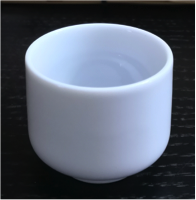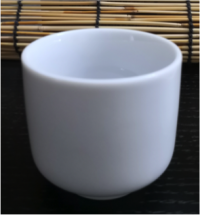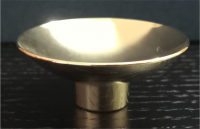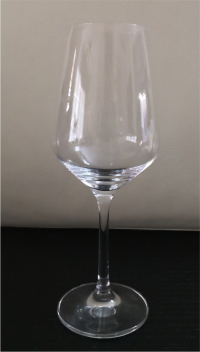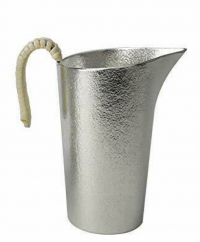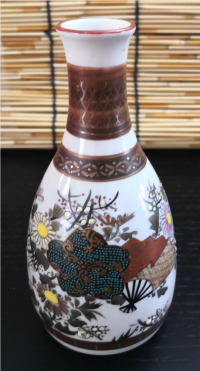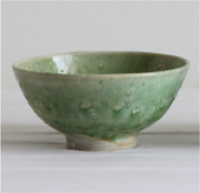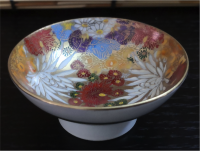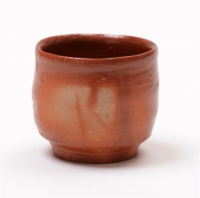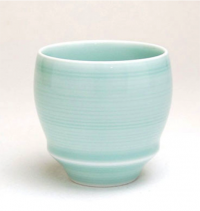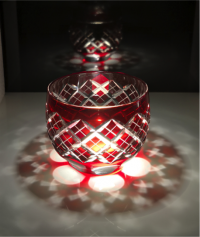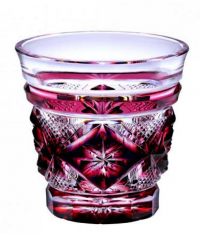Difference between revisions of "Serving and Drinking Vessels Lexicon"
(Copy and Paste from previous/old page.) |
|||
| (25 intermediate revisions by 3 users not shown) | |||
| Line 1: | Line 1: | ||
| − | + | '''SAKE SERVING AND DRINKING VESSELS''' | |
| − | |||
| − | |||
| − | |||
| − | |||
| − | |||
| − | + | Saké can be enjoyed both chilled, at room temperature, warmed or piping hot. In a hot environment such as during a hot summer a chilled saké seems like a natural choice. In Japan warm/hot saké are thoroughly enjoyed during winter. | |
| − | |||
| − | + | But there is also an important underlying reason why sakés are served and enjoyed at different temperature levels. As a general rule, unpasteurized saké, Ginjo and Daiginjo grade saké and sparkling saké which are high in aromatics are best served chilled and not warm or hot as the delicate fragrance of fruits, flowers and the sensation of freshness dissipates at higher temperatures. Saké that have fewer aromatics but higher acidity, a fuller body with plenty of umami are recommended to be enjoyed warm, hot or at room temperature. Higher temperatures tend to bring out the best expressions of these types of saké such as a Junmai, Yamahai or the laboriously produced Kimoto style saké. | |
| − | |||
| − | |||
| − | |||
| − | + | '''Recommended Saké Serving Temperatures''' | |
| − | |||
| − | + | Cold : 0°C - 5°C | |
| − | |||
| − | + | Chilled : 5°C - 15°C | |
| − | + | ||
| + | Lightly Chilled : 16°C – 18°C | ||
| + | |||
| + | Room Temperature : 19°C - 25°C | ||
| + | |||
| + | Warm : 26°C – 35°C | ||
| + | |||
| + | Hot : 36°C – 45°C | ||
| + | |||
| + | Very Hot : 46°C - 60°C | ||
| + | |||
| + | |||
| + | |||
| + | '''Saké Storage''' | ||
| + | |||
| + | It is recommended to store saké bottles in the refrigerator (0°C – 5°C) especially so for unpasteurized saké(Namazake) or cellar (10°C – 13°C) to maintain its freshness. An unfinished bottle of saké can be kept in the refrigerator and will still be enjoyable but its freshness and initial aromas will slowly diminish making the saké milder compared to when it was first opened and consumed. Some consumers and connoisseurs do enjoy this milder sensation. | ||
| + | |||
| + | If a fridge or chiller is not available, store saké bottles in a cool and dark area away from sunlight or UV light. | ||
| + | |||
| + | Most saké brewers encourage consumers to enjoy their saké fresh within a time frame of 1 – 2 years to experience as close to what they had intended their saké to taste like. But it does not mean that the saké will go bad after 2 years just that it will not taste as fresh and with some ageing notes developing in the bottle. This flavour profile can be quite desirable for some consumers too. | ||
| + | |||
| + | Saké bottles are best stored in an upright position to lessen the contact with the screw cap. As sakés in general are not bottled with a cork, there is no need to store saké lying down or horizontally to prevent the cork from drying out like wines. | ||
| + | |||
| + | |||
| + | '''Serving Vessels''' | ||
| + | |||
| + | They are many types of materials that can be used to make saké wares. These can range from ceramics, porcelain, glass, wood and metals such as gold, silver, pewter, tin, etc. | ||
| + | |||
| + | |||
| + | '''Some Common Types of Drinking Saké Wares:''' | ||
| + | |||
| + | ''O-choko/ Small saké cup 猪口'' | ||
| + | − These are the traditional cylindrical small saké cups that are more commonly seen in a Japanese restaurant setting. | ||
| + | [[File:O Choko.png|200px|thumb|centre|O Choko 猪口]] | ||
| + | |||
| + | |||
| + | ''Guinomi ぐい呑み'' | ||
| + | − A slightly bigger sized cup compared to the O-Choko. Saké can be poured straight from the saké bottle into a Guinomi cup. | ||
| + | [[File:Guinomi.png|200px|thumb|centre|Guinomi ぐい呑み]] | ||
| + | |||
| + | |||
| + | ''Masu 枡'' | ||
| + | − A square box that is made of Japanese cypress wood. Originally the Masu was used as a measurement instrument for agriculture produce such as rice. An ichi-go Masu contains 180ml of saké, so a regular sized bottle of saké (720ml) can serve 4 Masu filled to the brim. The Masu is still widely used especially during a Kagami-Biraki ceremony in Japan. | ||
| + | - In a restaurant, sometimes a small glass cup is put into the Masu and saké is poured into the cup till it overflows into the Masu. This is to demonstrate the generosity of the server by offering more than the customer ordered. | ||
| + | [[File:Masu.png|200px|thumb|centre|Masu 枡]] | ||
| + | |||
| + | |||
| + | ''Sakazuki 杯'' | ||
| + | - A shorter, wide mouth and almost flat shaped cup. Used mainly during ceremonies and festivities, such as during a Japanese Shinto wedding ceremony where the bride and bridegroom take turns to take 3 sips of saké from the cups. | ||
| + | [[File:Sakazuki.png|200px|thumb|centre|Sakazuki 杯]] | ||
| + | |||
| + | |||
| + | ''Wine Glass'' | ||
| + | − The usage of wine glasses is becoming more prominent as consumers learn to appreciate the highly fragrant Ginjo and Daiginjo saké. The shape and depth of wine glasses help to capture and retain the aromas better than the shallow and small traditional cups. | ||
| + | [[File:Wine Glass.png|200px|thumb|centre|Wine Glass]] | ||
| + | |||
| + | |||
| + | |||
| + | '''Common Types of Saké Servers''' | ||
| + | |||
| + | ''Chirori'' 銚釐 | ||
| + | − A type of small pot that is usually made of metal with a higher heat transfer rate such as tin. After saké has been poured into the chirori, it is put into hot water to warm it up before serving at the required temperature. | ||
| + | [[File:Chirori.png|200px|thumb|centre|Chirori 銚釐]] | ||
| + | |||
| + | |||
| + | |||
| + | ''Katakuchi'' | ||
| + | − A wide mouth carafe with a little spout to pour chilled saké into saké cups or glasses. | ||
| + | [[File:Katakuchi.png|200px|thumb|centre|Katakuchi]] | ||
| + | |||
| + | |||
| + | |||
| + | |||
| + | ''Tokkuri'' 徳利 | ||
| + | − A small bottle with a narrow turtle-neck that can be used to serve both hot and chilled saké. | ||
| + | [[File:Tokkuri.png|200px|thumb|centre|Tokkuri 徳利]] | ||
| + | |||
| + | |||
| + | |||
| + | '''Some examples saké cups made from traditional saké wares from different parts of Japan''' | ||
| + | |||
| + | Mino-yaki 美濃焼き (Gifu Prefecture) | ||
| + | − Mino wares are closely related to the Japanese Tea Ceremony | ||
| + | [[File:Mino ware.png|200px|thumb|centre|Mino ware 美濃焼き]] | ||
| + | |||
| + | |||
| + | Kutani 九谷焼 (Ishikawa Prefecture) | ||
| + | - Often seen with overglazed painting with vivid colours and calligraphy. | ||
| + | [[File:Kutani ware.png|200px|thumb|centre|Kutani ware 九谷焼]] | ||
| + | |||
| + | |||
| + | |||
| + | Bizen-yaki 備前焼 (Okayama Prefecture) | ||
| + | - Made from clay found around its historical namesake Bizen province in Okayama Prefecture. | ||
| + | [[File:Bizen ware.png|200px|thumb|centre|Bizen ware 備前焼]] | ||
| + | |||
| + | |||
| + | |||
| + | Karatsu-yaki 唐津焼 (Saga Prefecture) | ||
| + | − Traditionally made wares for everyday use to serve food and flower arangements in the household. | ||
| + | [[File:Karatsu ware.png|200px|thumb|centre|Karatsu ware 唐津焼]] | ||
| + | |||
| + | |||
| + | |||
| + | Arita-yaki 有田焼き (Saga Prefecture) | ||
| + | − Porcelain made in the town of Arita. | ||
| + | [[File:Arita ware.png|200px|thumb|centre|Arita ware 有田焼き]] | ||
| + | |||
| + | |||
| + | |||
| + | Edo Kiriko 江戸切子 (Tokyo) | ||
| + | - Sophisticated cut glass with vibrant colours and beautiful patterns made in Edo (now Tokyo). | ||
| + | [[File:Edo Kiriko.png|200px|thumb|centre|Edo Kiriko]] | ||
| + | |||
| + | |||
| + | |||
| + | |||
| + | Satsuma Kiriko 薩摩切子 (Kagoshima Prefecture) | ||
| + | - Another beautifully aesthetic cut glass from that has bold layers and more vivid colours. | ||
| + | [[File:Satsuma Kiriko.png|200px|thumb|centre|Satsuma Kiriko]] | ||
Latest revision as of 07:36, 31 August 2020
SAKE SERVING AND DRINKING VESSELS
Saké can be enjoyed both chilled, at room temperature, warmed or piping hot. In a hot environment such as during a hot summer a chilled saké seems like a natural choice. In Japan warm/hot saké are thoroughly enjoyed during winter.
But there is also an important underlying reason why sakés are served and enjoyed at different temperature levels. As a general rule, unpasteurized saké, Ginjo and Daiginjo grade saké and sparkling saké which are high in aromatics are best served chilled and not warm or hot as the delicate fragrance of fruits, flowers and the sensation of freshness dissipates at higher temperatures. Saké that have fewer aromatics but higher acidity, a fuller body with plenty of umami are recommended to be enjoyed warm, hot or at room temperature. Higher temperatures tend to bring out the best expressions of these types of saké such as a Junmai, Yamahai or the laboriously produced Kimoto style saké.
Recommended Saké Serving Temperatures
Cold : 0°C - 5°C
Chilled : 5°C - 15°C
Lightly Chilled : 16°C – 18°C
Room Temperature : 19°C - 25°C
Warm : 26°C – 35°C
Hot : 36°C – 45°C
Very Hot : 46°C - 60°C
Saké Storage
It is recommended to store saké bottles in the refrigerator (0°C – 5°C) especially so for unpasteurized saké(Namazake) or cellar (10°C – 13°C) to maintain its freshness. An unfinished bottle of saké can be kept in the refrigerator and will still be enjoyable but its freshness and initial aromas will slowly diminish making the saké milder compared to when it was first opened and consumed. Some consumers and connoisseurs do enjoy this milder sensation.
If a fridge or chiller is not available, store saké bottles in a cool and dark area away from sunlight or UV light.
Most saké brewers encourage consumers to enjoy their saké fresh within a time frame of 1 – 2 years to experience as close to what they had intended their saké to taste like. But it does not mean that the saké will go bad after 2 years just that it will not taste as fresh and with some ageing notes developing in the bottle. This flavour profile can be quite desirable for some consumers too.
Saké bottles are best stored in an upright position to lessen the contact with the screw cap. As sakés in general are not bottled with a cork, there is no need to store saké lying down or horizontally to prevent the cork from drying out like wines.
Serving Vessels
They are many types of materials that can be used to make saké wares. These can range from ceramics, porcelain, glass, wood and metals such as gold, silver, pewter, tin, etc.
Some Common Types of Drinking Saké Wares:
O-choko/ Small saké cup 猪口 − These are the traditional cylindrical small saké cups that are more commonly seen in a Japanese restaurant setting.
Guinomi ぐい呑み
− A slightly bigger sized cup compared to the O-Choko. Saké can be poured straight from the saké bottle into a Guinomi cup.
Masu 枡
− A square box that is made of Japanese cypress wood. Originally the Masu was used as a measurement instrument for agriculture produce such as rice. An ichi-go Masu contains 180ml of saké, so a regular sized bottle of saké (720ml) can serve 4 Masu filled to the brim. The Masu is still widely used especially during a Kagami-Biraki ceremony in Japan.
- In a restaurant, sometimes a small glass cup is put into the Masu and saké is poured into the cup till it overflows into the Masu. This is to demonstrate the generosity of the server by offering more than the customer ordered.
Sakazuki 杯
- A shorter, wide mouth and almost flat shaped cup. Used mainly during ceremonies and festivities, such as during a Japanese Shinto wedding ceremony where the bride and bridegroom take turns to take 3 sips of saké from the cups.
Wine Glass
− The usage of wine glasses is becoming more prominent as consumers learn to appreciate the highly fragrant Ginjo and Daiginjo saké. The shape and depth of wine glasses help to capture and retain the aromas better than the shallow and small traditional cups.
Common Types of Saké Servers
Chirori 銚釐 − A type of small pot that is usually made of metal with a higher heat transfer rate such as tin. After saké has been poured into the chirori, it is put into hot water to warm it up before serving at the required temperature.
Katakuchi − A wide mouth carafe with a little spout to pour chilled saké into saké cups or glasses.
Tokkuri 徳利
− A small bottle with a narrow turtle-neck that can be used to serve both hot and chilled saké.
Some examples saké cups made from traditional saké wares from different parts of Japan
Mino-yaki 美濃焼き (Gifu Prefecture) − Mino wares are closely related to the Japanese Tea Ceremony
Kutani 九谷焼 (Ishikawa Prefecture)
- Often seen with overglazed painting with vivid colours and calligraphy.
Bizen-yaki 備前焼 (Okayama Prefecture) - Made from clay found around its historical namesake Bizen province in Okayama Prefecture.
Karatsu-yaki 唐津焼 (Saga Prefecture) − Traditionally made wares for everyday use to serve food and flower arangements in the household.
Arita-yaki 有田焼き (Saga Prefecture) − Porcelain made in the town of Arita.
Edo Kiriko 江戸切子 (Tokyo) - Sophisticated cut glass with vibrant colours and beautiful patterns made in Edo (now Tokyo).
Satsuma Kiriko 薩摩切子 (Kagoshima Prefecture)
- Another beautifully aesthetic cut glass from that has bold layers and more vivid colours.
